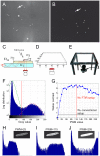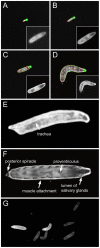FIM, a novel FTIR-based imaging method for high throughput locomotion analysis
- PMID: 23349775
- PMCID: PMC3549958
- DOI: 10.1371/journal.pone.0053963
FIM, a novel FTIR-based imaging method for high throughput locomotion analysis
Abstract
We designed a novel imaging technique based on frustrated total internal reflection (FTIR) to obtain high resolution and high contrast movies. This FTIR-based Imaging Method (FIM) is suitable for a wide range of biological applications and a wide range of organisms. It operates at all wavelengths permitting the in vivo detection of fluorescent proteins. To demonstrate the benefits of FIM, we analyzed large groups of crawling Drosophila larvae. The number of analyzable locomotion tracks was increased by implementing a new software module capable of preserving larval identity during most collision events. This module is integrated in our new tracking program named FIMTrack which subsequently extracts a number of features required for the analysis of complex locomotion phenotypes. FIM enables high throughput screening for even subtle behavioral phenotypes. We tested this newly developed setup by analyzing locomotion deficits caused by the glial knockdown of several genes. Suppression of kinesin heavy chain (khc) or rab30 function led to contraction pattern or head sweeping defects, which escaped in previous analysis. Thus, FIM permits forward genetic screens aimed to unravel the neural basis of behavior.
Conflict of interest statement
Figures





Similar articles
-
FIM imaging and FIMtrack: two new tools allowing high-throughput and cost effective locomotion analysis.J Vis Exp. 2014 Dec 24;(94):52207. doi: 10.3791/52207. J Vis Exp. 2014. PMID: 25591081 Free PMC article.
-
Quantifying subtle locomotion phenotypes of Drosophila larvae using internal structures based on FIM images.Comput Biol Med. 2015 Aug;63:269-76. doi: 10.1016/j.compbiomed.2014.08.026. Epub 2014 Sep 6. Comput Biol Med. 2015. PMID: 25280919
-
Kinesin heavy chain function in Drosophila glial cells controls neuronal activity.J Neurosci. 2012 May 30;32(22):7466-76. doi: 10.1523/JNEUROSCI.0349-12.2012. J Neurosci. 2012. PMID: 22649226 Free PMC article.
-
FIM$^{2c\;}$: Multicolor, Multipurpose Imaging System to Manipulate and Analyze Animal Behavior.IEEE Trans Biomed Eng. 2017 Mar;64(3):610-620. doi: 10.1109/TBME.2016.2570598. Epub 2016 May 18. IEEE Trans Biomed Eng. 2017. PMID: 28113210
-
Neurogenetics of courtship and mating in Drosophila.Adv Genet. 2008;62:67-184. doi: 10.1016/S0065-2660(08)00603-2. Adv Genet. 2008. PMID: 19010254 Review.
Cited by
-
Biallelic Variants in UBA5 Reveal that Disruption of the UFM1 Cascade Can Result in Early-Onset Encephalopathy.Am J Hum Genet. 2016 Sep 1;99(3):695-703. doi: 10.1016/j.ajhg.2016.06.030. Epub 2016 Aug 18. Am J Hum Genet. 2016. PMID: 27545681 Free PMC article.
-
Optimization of wrMTrck to monitor Drosophila larval locomotor activity.J Insect Physiol. 2016 Oct-Nov;93-94:11-17. doi: 10.1016/j.jinsphys.2016.07.007. Epub 2016 Jul 16. J Insect Physiol. 2016. PMID: 27430166 Free PMC article.
-
Ethoscopes: An open platform for high-throughput ethomics.PLoS Biol. 2017 Oct 19;15(10):e2003026. doi: 10.1371/journal.pbio.2003026. eCollection 2017 Oct. PLoS Biol. 2017. PMID: 29049280 Free PMC article.
-
Anion-conducting channelrhodopsins with tuned spectra and modified kinetics engineered for optogenetic manipulation of behavior.Sci Rep. 2017 Nov 2;7(1):14957. doi: 10.1038/s41598-017-14330-y. Sci Rep. 2017. PMID: 29097684 Free PMC article.
-
The Hunchback transcription factor determines interneuron molecular identity, morphology, and presynapse targeting in the Drosophila NB5-2 lineage.PLoS Biol. 2025 Mar 31;23(3):e3002881. doi: 10.1371/journal.pbio.3002881. eCollection 2025 Mar. PLoS Biol. 2025. PMID: 40163536 Free PMC article.
References
-
- Maimon G, Straw AD, Dickinson MH (2008) A simple vision-based algorithm for decision making in flying Drosophila. Curr Biol 18: 464–470. - PubMed
-
- Frye MA, Dickinson MH (2004) Closing the loop between neurobiology and flight behavior in Drosophila. Curr Opin Neurobiol 14: 729–736. - PubMed
-
- Fry SN, Sayaman R, Dickinson MH (2003) The aerodynamics of free-flight maneuvers in Drosophila. Science 300: 495–498. - PubMed
Publication types
MeSH terms
Substances
LinkOut - more resources
Full Text Sources
Other Literature Sources
Molecular Biology Databases

